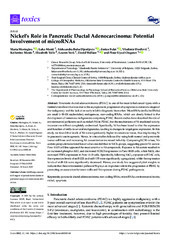Prikaz osnovnih podataka o dokumentu
Nickel’s Role in Pancreatic Ductal Adenocarcinoma: Potential Involvement of microRNAs
| dc.creator | Mortoglou, Maria | |
| dc.creator | Manić, Luka | |
| dc.creator | Buha-Đorđević, Aleksandra | |
| dc.creator | Bulat, Zorica | |
| dc.creator | Đorđević, Vladimir | |
| dc.creator | Manis, Katherine | |
| dc.creator | York, Lauren | |
| dc.creator | Valle, Elizabeth | |
| dc.creator | Wallace, David | |
| dc.creator | Uysal-Onganer, Pinar | |
| dc.date.accessioned | 2022-12-23T12:12:09Z | |
| dc.date.available | 2022-12-23T12:12:09Z | |
| dc.date.issued | 2022 | |
| dc.identifier.issn | 2305-6304 | |
| dc.identifier.uri | https://farfar.pharmacy.bg.ac.rs/handle/123456789/4352 | |
| dc.description.abstract | Pancreatic ductal adenocarcinoma (PDAC) is one of the most lethal cancer types with a limited overall survival rate due to the asymptomatic progression of symptoms in metastatic stages of the malignancy and the lack of an early reliable diagnostic biomarker. MicroRNAs (miRs/miRNAs) are small (~18–24 nucleotides), endogenous, non-coding RNAs, which are closely linked to the development of numerous malignancies comprising PDAC. Recent studies have described the role of environmental pollutants such as nickel (Ni) in PDAC, but the mechanisms of Ni-mediated toxicity in cancer are still not completely understood. Specifically, Ni has been found to alter the expression and function of miRs in several malignancies, leading to changes in target gene expression. In this study, we found that levels of Ni were significantly higher in cancerous tissue, thus implicating Ni in pancreatic carcinogenesis. Hence, in vitro studies followed by using both normal and pancreatic tumor cell lines and increasing Ni concentration increased lethality. Comparing LC50 values, Ni-acetate groups demonstrated lower values needed than in NiCl2 groups, suggesting greater Ni-acetate. Panc-10.05 cell line appeared the most sensitive to Ni compounds. Exposure to Ni-acetate resulted in an increased phospho-AKT, and decreased FOXO1 expression in Panc-10.05 cells, while NiCl2 also increased PTEN expression in Panc-10.05 cells. Specifically, following NiCl2 exposure to PDAC cells, the expression levels of miR-221 and miR-155 were significantly upregulated, while the expression levels of miR-126 were significantly decreased. Hence, our study has suggested pilot insights to indicate that the environmental pollutant Ni plays an important role in the progression of PDAC by promoting an association between miRs and Ni exposure during PDAC pathogenesis. | |
| dc.publisher | MDPI | |
| dc.relation | info:eu-repo/grantAgreement/MESTD/inst-2020/200161/RS// | |
| dc.relation | Oklahoma State University Center for Health Sciences (OVPR) Pilot/Seed Grant (AG154391) and Presidential Fellowship (to KM, LY, and LV) D.R.W.; | |
| dc.relation | University of Westminster, School of Life Sciences Research Enhancement Grant 2020 P.U.-O., M.M. is supported by University of Westminster SLS PhD Studentship | |
| dc.rights | openAccess | |
| dc.rights.uri | https://creativecommons.org/licenses/by/4.0/ | |
| dc.source | Toxics | |
| dc.subject | apoptosis | |
| dc.subject | environmental toxins | |
| dc.subject | microRNAs | |
| dc.subject | nickel | |
| dc.subject | non-coding RNAs | |
| dc.subject | pancreatic ductal adenocarcinoma | |
| dc.title | Nickel’s Role in Pancreatic Ductal Adenocarcinoma: Potential Involvement of microRNAs | |
| dc.type | article | |
| dc.rights.license | BY | |
| dc.citation.volume | 10 | |
| dc.citation.issue | 3 | |
| dc.citation.rank | M21 | |
| dc.identifier.wos | 000774451400001 | |
| dc.identifier.doi | 10.3390/toxics10030148 | |
| dc.identifier.scopus | 2-s2.0-85127707622 | |
| dc.identifier.fulltext | http://farfar.pharmacy.bg.ac.rs/bitstream/id/11322/bitstream_11322.pdf | |
| dc.type.version | publishedVersion |

